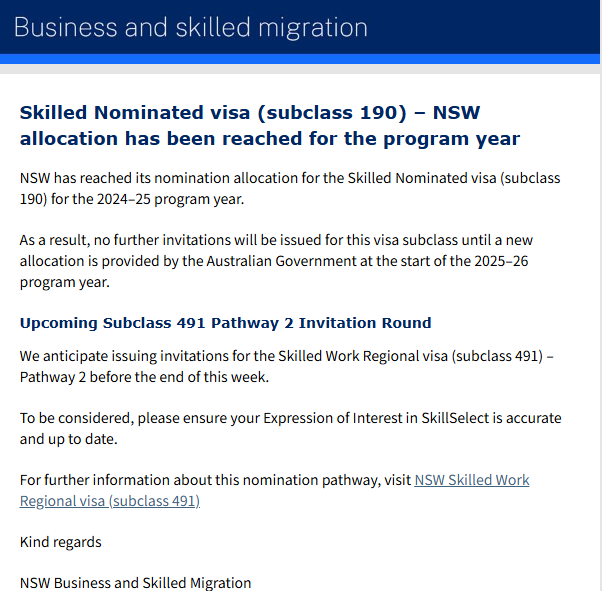NSW skilled migration update: 190 quota reached, 491 invitations continue — where are the current opportunities?
On 4 June, New South Wales (NSW) officially announced that the 2024–25 program year Skilled Nominated visa (subclass 190) allocation has been fully used, and no further invitations will be issued at this stage.
Just two days later, on 6 June, NSW released another round of 491 Skilled Work Regional visa (Pathway 2) invitations, signalling that 491 is now the primary active pathway with an ongoing positive invitation rhythm.

190 quota reached, time to prepare and reassess
With the current year’s 190 quota now fully utilised, applicants who were originally targeting this pathway should shift to a “prepare + monitor” mode, with a focus on:
-
Adjusting EOI points structure to enhance competitiveness
-
Considering regional work/study experience to strengthen positioning for the 491 pathway
-
Monitoring the new program year’s 190 policy direction and planning timelines accordingly
491 invitations remain active — industry trends to watch
This week’s new round of NSW 491 Pathway 2 invitations revealed several clear trends:
Onshore and offshore opportunities remain strong — Many offshore applicants are still receiving invitations, showing that NSW continues to seek quality skilled talent from overseas, particularly in IT, engineering, healthcare, and education.
Points range remains flexible — There were still invitations for applicants with 75–80 base points + state nomination points, meaning the pathway is not just limited to the highest-scoring profiles. Partner points, CCL, and work experience remain valuable factors for improving competitiveness.
Stable demand for skills-based occupations — IT, engineering, education, healthcare, manufacturing, and construction remain core areas for 491 Pathway 2 invitations, reflecting NSW’s strong demand for infrastructure and public service talent.
Genuine regional commitment increasingly important — Recent rounds show that applicants who do not demonstrate a clear intention to work/live in regional areas are less likely to be invited — points-only players face higher risks.
Overall, with the NSW 190 quota temporarily closed and 491 Pathway 2 invitations remaining active, this is a crucial time for applicants to strategically adjust their skilled migration plans. Both onshore and offshore applicants should proactively optimise their EOIs, strengthen their regional commitment, and actively pursue opportunities via the 491 pathway — while also preparing for the potential reopening of the 190 stream in the next program year. By staying in tune with current policy trends and pursuing a dual-pathway approach, applicants can improve their overall success rate and future competitiveness.
If you have any questions or would like professional assistance, please feel free to contact us at Riverwood Migration (Email: [email protected]). We are committed to providing transparent, expert migration services to help you achieve your dream of moving to Australia.






